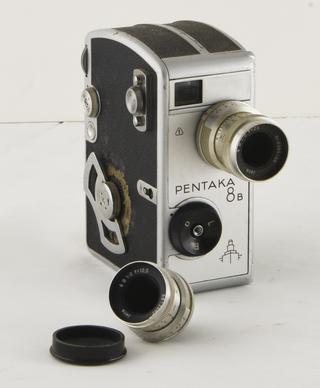
Aircraft Cine Camera Model G 45

Aircraft cine camera Model G.45. Using 16mm perforated cine film, 50 foot lengths, loaded into a special rechargable magazine. Works off the electricity supply of the aircraft, 24volt. Coupled to the trigger mechanism of the machine gun register a hit or miss. Standard lens has a focal length of 1 inch, the long focus approx 12". Both lenses have a heating element built into the front of the lens to eliminate condensation. Williamson c.1940
James A. Williamson (8 November 1855 – 18 August 1933) was a Scottish photographer and a key member of the loose association of early film pioneers dubbed the Brighton School. He trained to be a master chemist and moved to London in 1868, where he was an apprentice to a pharmacist. He was also a keen amateur photographer who sold photographic apparatus and chemical supplies in his own shop and became an agent for Kodak.
In 1886, he moved his chemist's and photographic business to 144 Church Road, Hove and formed friendships with fellow pioneers Esmé Collings, William Friese-Greene and George Albert Smith, among others, for whom he supplied chemicals and processed films. Williamson, who initially purchased and adapted an apparatus for local showings of Smith's films was, with assistance from the engineer Alfred Darling, able to create his own home-made filming apparatus and begin making films. He later formed the Williamson Kinematographic Company, whch continued after his death in 1933.
Details
- Category:
- Cinematography
- Collection:
- Arthur Frank Collection
- Object Number:
- 1979-559/729
- Materials:
- glass
- Measurements:
-
Camera: 90 mm x 55 mm x 310 mm,
Extension Lens: 85 mm x 50 mm x 365 mm,
- type:
- aircraft camera
- credit:
- The Arthur Frank Collection




